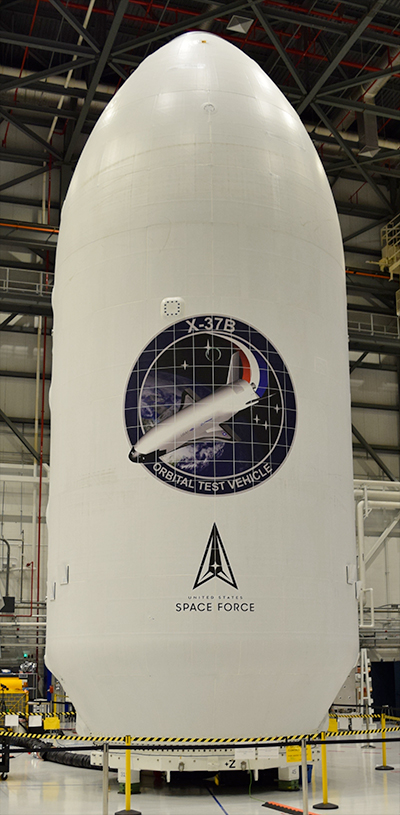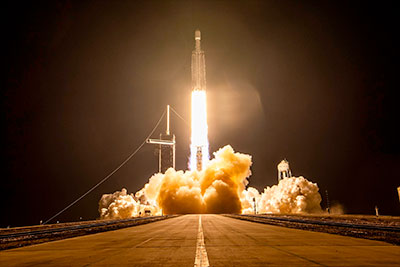Department of the Air Force Scheduled to Launch Seventh X-37B MissionThe Department of the Air Force Rapid Capabilities Office, in partnership with the United States Space Force, is scheduled to launch the seventh mission of the X-37B Orbital Test Vehicle Dec. 7, 2023 from Kennedy Space Center, Florida.

Above: Featuring the United States Space Force (USSF) logo for the first time, the encapsulated X-37B Orbital Test Vehicle for the USSF-52 Mission. (Boeing)
The X-37B Mission 7 will launch on a SpaceX Falcon Heavy rocket for the first time, designated USSF-52, with a wide range of test and experimentation objectives. These tests include operating the reusable spaceplane in new orbital regimes, experimenting with future space domain awareness technologies, and investigating the radiation effects on materials provided by NASA.
"We are excited to expand the envelope of the reusable X-37B's capabilities, using the flight-proven service module and Falcon Heavy rocket to fly multiple cutting-edge experiments for the Department of the Air Force and its partners," said Lt. Col. Joseph Fritschen, the X-37B Program Director.
X-37B Mission 7, also known as OTV-7, will expand the United States Space Force's knowledge of the space environment by experimenting with future space domain awareness technologies. These tests are integral in ensuring safe, stable, and secure operations in space for all users of the domain.
Chief of Space Operations, Gen. B. Chance Saltzman hailed these experiments as "groundbreaking," saying, "The X37B continues to equip the United States with the knowledge to enhance current and future space operations. X-37B Mission 7 demonstrates the USSF's commitment to innovation and defining the art-of-the-possible in the space domain."
The NASA experiment onboard will expose plant seeds to the harsh radiation environment of long-duration spaceflight. Known as "Seeds-2," the experiment will build upon the successes of prior experiments, paving the way for future crewed space missions.
Previously, X-37B Mission 6 was the first mission to introduce a service module that expanded the capabilities of the spacecraft and allowed it to host more experiments than any of the previous missions. The spacecraft carried the Naval Research Laboratory's Photovoltaic Radio-frequency Antenna Module experiment, which transformed solar power into radio frequency microwave energy, and two NASA experiments to study the results of radiation and other space effects on a materials sample plate and seeds used to grow food. The X-37B Mission 6 also deployed FalconSat-8, a small satellite developed by the U.S. Air Force Academy and sponsored by the Air Force Research Laboratory.
The Director of the DAF RCO, William D. Bailey, praised the collaborative partnership with industry, noting, "The X-37B government and Boeing teams have worked together to produce a more responsive, flexible, and adaptive experimentation platform. The work they've done to streamline processes and adapt evolving technologies will help our nation learn a tremendous amount about operating in and returning from a space environment."













